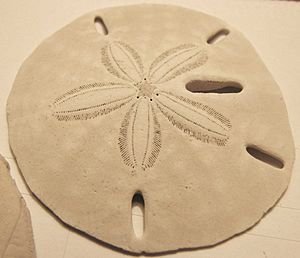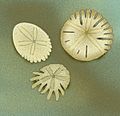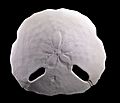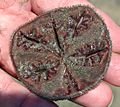Sand dollar facts for kids
Quick facts for kids Sand dollar |
|
|---|---|
 |
|
| Living sand dollars look rather different from the white tests found on the beach. |
|
| Scientific classification | |
| Domain: | |
| Kingdom: | |
| Phylum: | |
| Class: | |
| Superorder: |
Gnathostomata
|
| Order: |
Clypeasteroida
|
Sand dollars are a special type of sea urchin. They are flat and like to burrow, meaning they dig into the sand. You can find them in many parts of the world, especially in warmer areas. They live from the shallow parts of the ocean all the way down to very deep areas.
Every sand dollar has a hard outer shell called a test. This is the white, round shape you often find on beaches. When they are alive, sand dollars have tiny, moving spines all over their test. These spines help them move around. Like other sea urchins, sand dollars have five pairs of holes on their body. These holes are arranged in a pattern that looks like flower petals. Through these holes, their tube feet stick out. These tube feet help them breathe.
Contents
What Sand Dollars Look Like
Living sand dollars are covered in small spines. These spines are much softer and shorter than the ones on a regular sea urchin. Sand dollars also have tube feet, just like all echinoderms. But sand dollars don't use their tube feet to move. Instead, they use them to breathe!
The tube feet actually stick out from the top of the sand dollar. If you look at a sand dollar's test, you'll see a pattern that looks like a flower. This pattern is made of many tiny holes. These are the holes where the sand dollar's tube feet came out when it was alive.
A sand dollar uses its tiny spines to move. It also uses them to dig into the sand. Often, a sand dollar will bury itself completely. Sometimes, it only buries part of its body. It might even stand on its side, poking up from the sand.
How Sand Dollars Eat
On the bottom side of a sand dollar, there is a star-shaped pattern. This pattern spreads out from the center, where the sand dollar's mouth is. These star-shaped lines are called food grooves.
Sand dollars filter sand and water to find food. They catch tiny bits of plankton and other small things on their spines. Then, tiny hairs called cilia move the food. The food travels along the food grooves to the sand dollar's mouth. They eat things like tiny crustacean larvae, small copepods, diatoms, algae, and other small particles.
Where Sand Dollars Live
Sand dollars are very special sea urchins. All their body parts help them dig into the sand. They live just under the sand. They might lie flat or at an angle. When they are at an angle, they face the ocean currents. This helps them catch food. Sand dollars can live for up to 10 years.
Sand Dollar Colors
Most living sand dollars have dark colors. They can be brown or purple. Their dark color helps them hide. They can easily blend in with the sand, mud, or the sea floor. The tests you find on the beach are usually white. This is because the sun bleaches them after the sand dollar has died.
Images for kids
-
Leodia sexiesperforata by Louis Agassiz (1841)
-
Encope emarginata (aboral and oral faces) by Ernst Haeckel (1904)
-
Clypeaster rosaceus (aboral and oral faces) by Ernst Haeckel (1904)
-
Eccentric sand dollars (Dendraster excentricus) at Monterey Bay Aquarium.
-
Sand dollar beneath the sand at low tide on Hilton Head Island
-
Live sea biscuit, Clypeaster rosaceus, commonly found off Key Biscayne, Florida
See also
 In Spanish: Clipeasteroides para niños
In Spanish: Clipeasteroides para niños

















